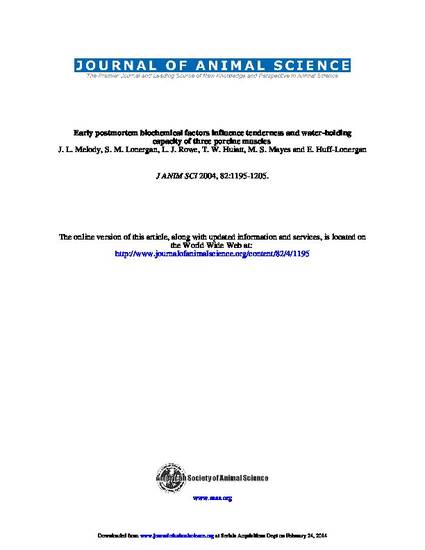
The objective of this study was to determine whether differences in pork tenderness and water-holding capacity could be explained by factors influencing calpain activity and proteolysis. Halothane-negative (HAL-1843 normal) Duroc pigs (n = 16) were slaughtered, and temperature and pH of the longissimus dorsi (LD), semimembranosus (SM), and psoas major (PM) were measured at 30 and 45 min and 1, 6, 12, and 24 h postmortem. Calpastatin activity; μ-calpain activity; and autolysis and proteolysis of titin, nebulin, desmin, and troponin-T were determined on muscle samples from the LD, SM, and PM at early times postmortem. Myofibrils from each muscle were purified to assess myofibril-bound μ-calpain. Percentage drip loss was determined, and Warner-Bratzler shear (WBS) force was analyzed. Myosin heavy-chain (MHC) isoforms were examined using SDS-PAGE. The pH of PM was lower (P < 0.01) than the pH of LD and SM at 30 and 45 min and 1 h postmortem. The PM had a higher (P < 0.01) percentage of the MHC type IIa/IIx isoforms than the LD. The LD had the greatest proportion of (P < 0.01) MHC IIb isoforms of any of the muscles. The PM had the lowest (P < 0.01) percentage of MHC IIb isoforms and a greater (P < 0.05) percentage of type I MHC isoforms than the LD and SM. The PM had less (P < 0.01) drip loss after 96 h of storage than the SM and LD. The PM had more desmin degradation (P < 0.01) than the LD and SM at 45 min and 6 h postmortem. Degradation of titin occurred earlier in the PM than the LD and SM. At 45 min postmortem, the PM consistently had some autolysis of μ-calpain, whereas the LD and SM did not. At 6 h postmortem, some autolysis of μ-calpain (80-kDa subunit) was observed in all three muscles. The rapid pH decline and increased rate of autolysis in the PM paralleled an earlier appearance of myofibril-bound μ-calpain. The SM had higher calpastatin activity (P < 0.05) at 45 min, 6 h, and 24 h and had higher WBS values at 48 h (P < 0.01) and 120 h (P < 0.05) postmortem than the LD. At 48 and 120 h postmortem, more degradation of desmin, titin, and nebulin were observed in the LD than in the SM. These results show that μ-calpain activity, μ-calpain autolysis, and protein degradation are associated with differences in pork tenderness and water-holding capacity observed in different muscles.
Available at: http://works.bepress.com/steven_lonergan/83/

This article is from Journal of Animal Science 82 (2004): 1195–1205. Posted with permission.